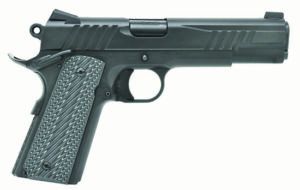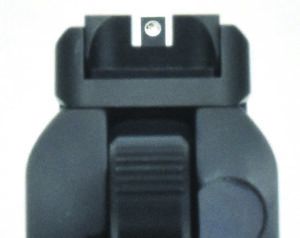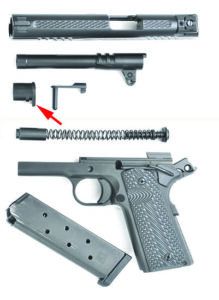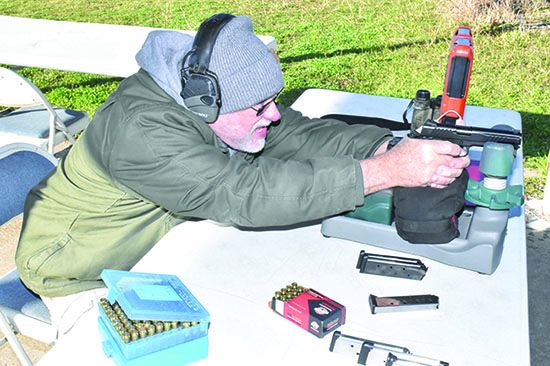Ranging in experience from the veteran of a few action-pistol matches to a few decades, all the members of the Houston test group are competitive shooters. Soon to recognize the 40th anniversary of his first USPSA match, the most ancient among the team has witnessed the pitfalls of the 1911 platform as a competition pistol, and he talks frequently about the advancements made in today’s offerings versus those of yesteryear. So our shooters thought you might like to see some solid examples of what makes today’s firearms better in many respects than what we had back in the day.
To do that, we chose as a base pistol a Series 70 Colt Government Model, a 50-plus-year-old pistol on loan to us. Slightly modified, we used it for illustration purposes only. The two modern-day handguns were a Ruger SR1911 Product No. 6700, a 45 ACP with a bead-blast stainless finish and contrasting controls, $929. Second is the very new Savage 1911 Govt Style Black Nitride 67200 with adjustable sights and forward cocking serrations, $1280. As you can see, the Savage costs a third again what the Ruger does, so we had to know if it was worth the difference. First, because you’re likely more interested in what current factory pistol you might want to buy, we detail how the Ruger and Savage shooters compare to each other. Then, at the end of this article, we illustrate what we feel are the major differences between them and our historical Colt.
The dinosaur in this test group shot his first USPSA match in April 1984 with a Series 70 Colt Government Model 1911 much like the sample in the photos on page 22. Little did he know how much he was going to have to spend before that pistol qualified as “match ready” for USPSA. Colt was the brand back then, along with some assistance from Springfield Armory. Both seemed to require that the shooter disassemble his pistol immediately upon purchase and take that bag of parts, along with more he ordered from Brownells or the like, to a talented gunsmith for tuning and reassembly. Wait times for the work were usually months, and costs were high. The new competitor could expect to pay around $1000 to the gunsmith, plus the cost of the base pistol, both in 1980 dollars, for something that would shoot accurately and work consistently.
Let’s face it, while the 1911 is an incredible design that is still relevant more than 110 years after its acceptance by the U.S. military, it had its weak points. John Moses Browning may be the greatest firearms inventor who ever lived, but the 1911 still needed its own generations of improvements to get to where it is today. The sights were too small, the barrel bushing was prone to breakage, accuracy was only fair, the trigger needed some help, and, amazingly, it was difficult to eject a loaded round. Add to that, the older gun had a lot of moving parts that needed to be kept somewhat clean to function.
Over the years, shooters and gunsmiths have learned what needed to be done to make the 1911 platform work, and to be honest, the 1911 still has quite a few parts that need some love. We find ourselves needing to maintain our 1911s more than, say, a Gen 5 Glock, and we now know where to and how much to lube the older pistols. We look back at those days and shake our heads at what we gripe about paying today and what we get for it.
Our comparison of the Ruger and Savage pistols highlight many features that weren’t available from the factory 50 years ago, but which are over-the-counter offerings today. Let’s dig into the new pistols:
Savage 1911 Govt Style Black Nitride 67200 45 ACP
$1328
Gun Tests grade: B+
The Savage may be the same platform and the same chambering as the Ruger, but it has a few more bells and whistles. Depending on the shooter, it may well be worth the extra $400.

| Action | Semi-auto single action, hammer fired |
| Overall Length | 8.7 in. |
| Overall Height | 5.5 in. |
| Maximum Width | 1.515 in. |
| Weight Unloaded | 2.35 lbs. |
| Weight Loaded | 2.86 lbs. |
| Slide Material | Stainless steel |
| Slide Retraction Effort | 17.6 lbs. |
| Receiver Material | Stainless steel |
| Finish | Black nitride |
| Front Strap Height | 2.75 in. |
| Back Strap Height | 3.25 in. |
| Barrel | 5.0 in. long, 1:16 RH twist |
| Grip Thickness (Maximum) | 1.30 in. |
| Grip Circumference | 5.4 in. |
| Magazines | (2) 8-round |
| Rear Sight | Novak Lo-Mount Black rear sight, adjustable; white-dot front sight |
| Sight Radius | 6.5 in. |
| Trigger-Pull Weight | 3.12 lbs. |
| Trigger Span | 3.0 in. |
| Safeties | Manual ambi thumb lever, grip |
| Warranty | 1 year Limited, original owner |
| Telephone | (800) 370-0708 |
| Website | SavageArms.com |
| Made In | U.S. |
Savage took advantage of 100+ years of collective experience with the 1911 platform and went swinging for the fences on their first modern 1911 pitch. Changes in concept versus the Ruger are obvious from the beginning. The slide and frame are forged stainless steel with a matte-black nitride finish. This leaves the pistol even more resistant to weather and wear than good stainless-steel metalwork alone.
Then Savage added in a few nice touches on the slide. We found five diagonal slots milled on the front of the slide to match those on the rear. These are perfect for press checks, which we perform. A very stylish cut has been made into the slide just above those forward serrations. Necessary? No, but it adds a distinctive flair to the pistol. Like the Ruger, the front end of the Savage’s muzzle has been rounded just a bit to aid in reholstering. And the Savage went further in beveling the outside bottom edge of the slide. That is often a sharp edge that can do nasty things to the hand when rapidly manipulating the slide. The ejection port has been properly lowered and flared, along with a teardrop-shaped cut at the lower rear, further protecting ejected brass.

The top of the slide has been flattened and scalloped to reduce glare on the sights. A single white dot appears on the post front sight, which is mounted in a dovetail cut in the slide. It is tall enough to see through the rear sight and just thin enough to leave a little light showing around the outside edge. The rear sight is another Novak design, but this one is adjustable for elevation and windage. It also has the plain black rear blade we prefer.
The barrel is a 5-inch stainless-steel match version with an 11-degree target crown and has also been nitrided. The barrel bushing was tight and did not move much without a proper wrench. The recoil spring was a dual nested affair that still was not as heavy as the Ruger. Lockup was tight, but we could detect slight movement when we pressed on the barrel hood. The extractor was internal and looked to be properly cut.
Savage stayed with the dark look on the black-nitrided frame and attached parts. The beavertail safety blended well with the frame and was even a bit wider than that on the Ruger. Protection from the Commander-style hammer was perfect. It had the memory pad on the bottom that we think should be mandatory but, apparently, not all manufacturers agree with us. The flat mainspring housing has also been modified to help with proper recoil control, but in this case, the Savage uses more of the scallops found on top of the slide instead of checkering. It was easier on the hand but did not provide quite as secure a grip. The magwell was nicely beveled. The front strap is smooth (something a competitive shooter would quickly remedy), and the grip frame was fitted with nicely grooved G10 panels.

The checkered magazine release is left side only, but this pistol has an ambidextrous thumb safety. We check for any slop on ambi safeties and discovered the Savage unit was very tight. Then we figured out why; there is a small set screw in the right safety that pushed against the hinge pin and kept everything rock solid. Nice touch.
The trigger was solid with no overtravel screw, which surprised us a bit. That said, take up and overtravel were good, with the Savage requiring an average 3.12 pounds of compression as measured with 10 pulls from our Lyman digital trigger gauge. We remember the days of 7-pound trigger pulls coming from the factory along with the look in our gunsmith’s eyes when we begged for a 2-pound pull. We could have worked with this unit as is.
Our team liked the styling and the feel of this pistol. The Savage felt like we were shooting a good bit faster than the Ruger. But that’s not what the numbers said. The Savage lost the first set of drills by 0.009 second (can the CED 7000 timer really measure important times that precisely?), It won the three-shot drill by 0.16 seconds spread across three shots. Then it lost the five-shot drill by an average of 0.014 seconds. Those differences are statistically insignificant. The Savage averaged 1.64 inches across all groups, while showing a preference for the Black Hills HoneyBadger 135-grain fodder.
Our Team Said: Function was perfect through all of the drills, even with the perhaps oversized reloads. The buyer must decide if the difference in looks, along with an adjustable rear sight and an ambi safety, is worth the extra cash.
| 45 ACP RANGE DATA | ||
| Black Hills HoneyBadger 135-grain Fluted Copper | Ruger SR1911 | Savage 1911 |
| Average Velocity | 1223 fps | 1202 fps |
| Muzzle Energy | 448 ft.-lbs. | 433 ft.-lbs. |
| Smallest Group | 1.27 in. | 1.15 in. |
| Average Group | 1.45 in. | 1.44 in. |
| Hornady Critical Defense 185-grain Jacketed HP | Ruger SR1911 | Savage 1911 |
| Average Velocity | 981 fps | 967 fps |
| Muzzle Energy | 395 ft.-lbs. | 384 ft.-lbs. |
| Smallest Group | 1.04 in. | 1.78 in. |
| Average Group | 1.39 in. | 1.85 in. |
| Remington Golden Saber 230-grain Jacketed HP | Ruger SR1911 | Savage 1911 |
| Average Velocity | 804 fps | 793 fps |
| Muzzle Energy | 330 ft.-lbs. | 321 ft.-lbs. |
| Smallest Group | 1.27 in. | 1.42 in. |
| Average Group | 1.48 in. | 1.78 in. |
How we tested: We fired these pistols at American Shooting Centers in West Houston. Accuracy was tested at 15 yards by shooting multiple five-shot groups from a well-sandbagged Caldwell Pistolero shooting rest (MidwayUSA.com Product No. 517357, $28) assisted by a Mini DRC Fortune Cookie from Wiebad.com ($75, Product No. MINIFC). We found our ammo through Ammoseek.com, firing Black Hills 135-grain HoneyBadgers, Hornady Critical Defense 185-grain JHPs, and Remington 230-grain Golden Saber JHPs. We function tested with a USPSA load consisting of Bayou Bullets 230-grain round-nose lead bullets, VihtaVuori N310 powder, and large pistol primers. Power factor (bullet weight x muzzle velocity/1000) was right at 168 (165 is required for USPSA major caliber scoring), and these are some of the softest competition loads we’ve ever shot.
| DRILL NO. 1 DATA | |
| Pistol | Single Shot Average Time |
| Ruger SR1911 | 0.743 |
| Savage 1911 Gov’t | 0.752 |
Process: Fire one shot from low ready at A Zone target (5-by-11 inches) placed at 8 yards. Numbers are averages for six repetitions. Times are in seconds.
| DRILL NO. 2 DATA | |||
| Pistol | 1st Shot | Split Average | Total Time |
| Ruger SR1911 | 0.96 | 0.24 | 1.455 |
| Savage 1911 Gov’t | 0.883 | 0.201 | 1.293 |
Process: Fire three shots from low ready at A Zone target (5-by-11 inches) placed at 8 yards. Numbers are averages for three repetitions. Times are in seconds.
| DRILL NO. 3 DATA | |||
|---|---|---|---|
| Pistol | 1st Shot | Split Average | Total Time |
| Ruger SR1911 | 0.845 | 0.216 | 1.693 |
| Savage 1911 Gov’t | 0.855 | 0.208 | 1.707 |
Process: Fire five shots from low ready at A Zone target (5-by-11 inches) placed at 5 yards. Numbers are averages for three repetitions. Times are in seconds.
Written and photographed by Joe Woolley, using evaluations from Gun Tests Team members. GT




























Where’s the data on the tiger?
Where’s data on ruger ?
Look up about 8 inches and see “Next article
Ruger SR1911 06700 45 ACP”